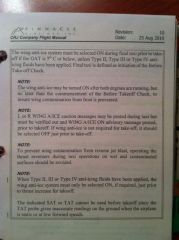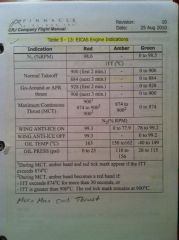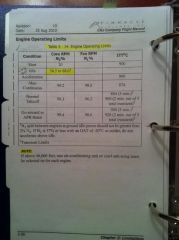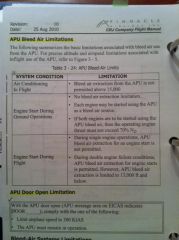![]()
![]()
![]()
Use LEFT and RIGHT arrow keys to navigate between flashcards;
Use UP and DOWN arrow keys to flip the card;
H to show hint;
A reads text to speech;
78 Cards in this Set
- Front
- Back
- 3rd side (hint)
|
Main Cabin Door
|
4 passengers or 1,000 lbs
|
|
|
|
Cargo
|
-Fly within 45min of suitable airport if carried
-Max weight is 3,500lbs |
|
|
|
Altitude and temperature limitations
-Max pressure altitude for T/L? -Max operating altitude? -Max alt on one pack? -Max temp for T/L? -Min temp for takeoff? |
-10,000
-41,000 / 37,000 company -25,000 -ISA +35C - -40C |
|
|
|
Initial pitch target for rotation?
|
10 degrees
|
|
|
|
Structural Weight Limitations?
-Max taxi & ramp? -Max T/O (MTOW)? -Max landing weight (MLW)? -Max zero fuel weight (MZFW)? -Min flight weight? |
-53,250lbs
-53,000 -47,000 -44,000 -30,000 |
CFM 3-14 Double Box
|
|
|
What are the Max runway slopes?
|
+/- 2 %
|
|
|
|
Wind Conditions:
-Max tailwind for T/L? -Max X-wind for T/L on dry/wet runway? -Max X-wind for T/L on contaminated runway? |
-10
-27 -15 |
|
|
|
Operating in Icing Conditions (double boxed):
Visible moisture Definition? |
Visible moisture includes clouds, fog with visibility of one mile (grounds ops) or less, rain, snow, sleet or ice crystals.
|
|
|
|
Engine Cowl Anti-Ice, Ground Operations: (double box)
|
The COWL ANTI-ICE must be on when:
-The OAT is 10C or below and visible moisture in any form is present. -The OAT is 10C or below when operating on runways, ramps, or taxiways where surface snow, ice, standing water, or slush is present. |
|
|
|
Wing Anti-Ice, Ground Operations: (double box)
|
The WING ANTI-ICE system must be on for takeoff when icing conditions exist on the ground, the OAT is 5C or below and:
-Visible moisture in any form is present below 400AGL -The runway is wet or contaminated -In the presence of any precipitation NOTE: If the wing anti-ice system is selected ON for takeoff, the cowl anti-ice system must also be selected ON. (Continued with photo on flashcard titled "Wing/Engine Anti-Ice Ground Operations Limitations? (Con't)" |
Clarification: For example if it is 5C out with no icing conditions, the wing anti-ice must only be on until sufficiently warm, then may be shut off prior to takeoff.
|
|
|
Wing/Engine Anti-Ice Ground Operations Limitations? (Con't)
|

|
|
|
|
Engine Cowl Anti-Ice, Flight Operations: (double box)
|
The COWL ANTI-ICE system must be on when:
-In icing conditions -ICE is annunciated by the ice detection system |
|
|
|
Wing Anti-Ice, Flight Operations: (double box)
|
The WING ANTI-ICE system must be on when:
-Ice is annunciated by the ice detection system -In icing conditions and below 230 knots. |
|
|
|
Airspeed Limitations:(double box)
Vfe 8-company Vfe 20-company Vfe 30-company Vfe 45-company Vfo 8- Vfo 20- Vfo 30- Vfo 45- |
-215kts
-215kts -185kts -170kts -200kts -200kts -185kts -170kts |
|
|
|
List of Immediate Action Items:
|
-Aileron system jammed
-APU FIRE message -Asymetric Braking/Loss of Braking -BRAKE OVHT Message -Cabin ALT message or Emergency Descent Procedure -Configuration Warning -Ditching or Forced Landing imminent -Double Engine Failure -Elevator System Jammed -ENGINE OVERSPD message -L(R) ENGINE FIRE Message or Severe Engine Damage (on ground) -L(R) ENGINE FIRE message or Severe Engine Damage (in flight) -L(R) JETPIPE OVHT message -L(R) REV UNLOCKED Message -Loss of all AC Power -MLG BAY OVHT Message -Passenger Evacuation -Post-Shutdown Engine Tail Pipe Fire -Rejected Takeoff -Rudder System Jammed -STAB TRIM Runaway -Stall Recovery |
|
|
|
Max Landing gear Operating speeds:
VLE? VLO up? VLO down? |
-250kias
-200kias -250kias |
|
|
|
Miscellaneous Speeds:
Max windshield wiper speed? Max tire ground speed? Max turbulent air penetration speed? STAB or MACH TRIM INOP max speed? |
-220
-182 -280kias or .75mach (lowest) -250kias or .70mach (unless auto pilot) -NOTE: when below Vref + 10knots, angle of bank 15 degrees. |
|
|
|
Minimum Operating Limit Speed:(double boxed)
|
Intentional speed reduction below the onset of stall warning, as defined by stick shaker operation, is prohibited, unless a lower speed is specifically authorized for flight test or training operation.
|
|
|
|
Minimum Climb Speed (Company)(double box)
|
Above 10000: climb at 250KIAS/.70Mach unless:
1.When mtn terrain in dept path, climb at Vx or Vref +10knots until clear or MEA. 2. Vy when requested except in icing cond above 15,000 feet. 3. If restricted by MEL, maintain highest speed allowed by the MEL, but not slower than Vx. When unable to maintain 300FPM @ 250KIAS/.70Mach, stop climb and coordinate new altitude with ATC. |
|
|
|
Minimum Enroute Cruise Speed (Company):
|
Above FL310 is Long Range Cruise LRC.
Below FL 310 is Two Engine Holding Vmd in calm air. Reference buffet margin chart during turb air. |
|
|
|
Engine Indications? (double box)
|
Red-Max and Min Limitations
Amber- Caution Range Green- Normal Operating Range |
|
|
|
What are the EICAS Engine Indications?
|

|
|
|
|
What are the Engine Operating Limits?
|

|
|
|
|
Airplane Cold-Soaked? (double box)
|
Before first flight of the day -30C or below for more than 8 hours:
-motor engines for 60 seconds, fan rotation verified before start is initiated -Reverse thrusters must be actuated until the deploy and stow cycles are less than 5 seconds. |
|
|
|
When must Continuous Ignition be used? (DB)
|
-Takeoff and landings on contaminated runways
-Takeoffs with X-wind > 10knots -Flight through moderate or heavier intensity rain -Flight through moderate or heavier intensity turbulence -Flight in the vicinity of thunderstorms Engine op at or near the shaker and pusher settings is predicated on an operable auto-ignition system |
|
|
|
Describe Engine Stabilization? (DB)
|
-Engines must be running for at least two minutes prior to takeoff
-prior to shutdown, IDLE for 2 minutes to dissipate heat and stabilize internal op temps. -If ITT >350C and is increasing rapidly following shutdown, carry out an engine motoring cycle to cool ITT. NOTE: Taxi time at 80% N2 or below may be considered in the 2 minute cool down period. |
|
|
|
When must the starter not be used (Ground and Air)? (DB)
|
Not able to use if N2 exceeds 55%
|
|
|
|
Associated Start Condition? (DB)
|
Thrust Lever movement from SHUT OFF to IDLE:
-ITT < 120C or less for all ground starts -ITT <90C or less for all air starts |
|
|
|
Dry motoring Cycle? (DB)
|
The dry motoring cycle (with Thrust Levers @ SHUT OFF) may be used for engine ground starts and engine air starts.
#1, 90 seconds, 5 min off #2+, 30 seconds, 5 min off |
|
|
|
Reduced Thrust Takeoff:
When can reduced thrust not be used? (DB) |
-Normal fan speed <85% N1
-Engine cannot achieve full rated thrust -Wing/cowl anti-icing bleeds in use -Contaminated runways with water, slush, snow or ice -Windshear and downdrafts warnings -Special Departure Procedure specifies full thrust for takeoff -Anti-skid inop NOTE: procedure may be used on wet runways provided that wet runway airport analysis data is used. If reduced thrust can be used, fan speed cannot be < 85% N1 |
|
|
|
Fuel System Limitations: (double box)
|
Max fuel imbalance between L & R is 800 pounds.
Wing tanks must be above 4400 pounds to have greater than 500 pounds in center tank The minimum fuel for a go around is 450# per wing when level. This assumes 10 degree nose up |
|
|
|
Fuel Temperature Limitations:
|
Take off with engine fuel temperature indications below 5C is prohibited.
When using JET A, bulk temp must be > -30C. IF non-std fuel is used refer to table 3-19. |
|
|
|
What are the fuel cross flow procedures for Takeoff?
|
Powered and gravity crossflow must be off for takeoff.
|
|
|
|
Hydraulic System Limitations?
|
The 3B pump must be ON for all phases of flight unless directed otherwise by an abnormal or emergency procedure.
|
|
|
|
Oil System Limitations?
|
Types- 1, 2, Castrol 4000
Max oil consumption: 6.4 ounces/hour or 189 cubic inches Oil Level Checks: max w/o servicing is 16 hours, after 16 hours must be checked from ENGINE OIL LEVEL panel w/in 3min to 2 hours after every shutdown. |
|
|
|
Oil Replenishment System?
|
-must be used from 15min to 2 hours after shutdown
-If more than 2 quarts used, must dry motor the engine -procedure done my Mx personnel |
|
|
|
APU indications? (double box)
|
Red- Max and Min limitations
Amber- Caution Range Green- Normal Operating Range |
|
|
|
What are the APU starting limitations? (DB)
|
Min ambient temp for starting a cold soaked APU on the ground is -40C.
|
|
|
|
Limitations on starting the APU on Battery? (DB)
|
first, 30s on, 2min off
second, 30s on, 20min off third, 30s on, 2min off fourth, 30s on, 40min off |
|
|
|
Limitations on starting the APU on DC Ground Power?
|
first, 15s on, 2min off
second, 15s on, 20min off third, 15s on, 2min off fourth, 15s on, 40min off |
|
|
|
What is the APU Door Open Limitation? (DB)
|
With the APU door open (APU message area in EICAS indicates DOOR_ _ _ _), comply with one of the following:
-speed < 300KIAS -APU must remain in operation |
|
|
|
What are the Bleed-Air System Limitation?
|
10th stage valves must be closed for takeoff and landing if the engine cowl and/or wing anti-ice systems have been selected ON.
|
|
|
|
What are the Air Cond and Pressurization Max Differential Pressures?
|
+8.7psi, -0.5psi, Taxi & Takeoff & Landing is 0.1psi
Must depressurize before opening any doors N/A EMER DEPRESS switch above 15,000 feet NOTE: When low-pressure air ground connection is used, cabin doors must be open. |
|
|
|
What is the Electrical System Limitations for Loads on the DC System?
|
The max permissible continuous on each TRU is 100 amps.
|
|
|
|
What is the max amount of time of DC ground power use to avoid damage to the CRT displays? (DB)
|
5 minutes.
|
|
|
|
What are the Wheel Brake Cooling Limitations? (DB)
|
Brake cooling times must be observed after a landing or RTO and a subsequent takeoff, to ensure its ability to stop the aircraft if needed on the next takeoff.
|
|
|
|
What are the Flap Control Limitations?
|
-Takeoff flaps must be selected from the 0 detent
-N/A touch and go training with 14knots+ X-wind. -Enroute use of flaps N/A, unless guidance from MOC during ferries. (DB) -Ops above 15000 with flaps extended N>A. (DB) |
|
|
|
What is the Flap Extended Diversion AD? (DB)
AD 2009-06-12 |
Upon arrival at dest, flaps will stay at 0 unless using precision approach and RVR is at or above mins and will remain there from the main body of the TAF until after landing. When using a non-precision approach ceiling AND visibility are controlling.
|
CFM 3-45
|
|
|
What are the conditions with a Flap Failure and when a Takeoff Alternate is filed?
|
-Min flight alt cannot exceed 15000 AND Fuel on board, at dept, shall be sufficient to divert to takeoff alternate or other suitable airport, with flaps extended to takeoff position, conduct approach, and land with 1000# fuel remaining.
|
|
|
|
What are the Limitations on the Flight Spoilers? (DB)
|
-N/A below 1000 feet
-N/A below recommended approach/maneuvering (Vref) speeds plus 17KIAS (NOTE: When maneuvering up to 40 bank, add 10KIAS to the recommended approach/maneuvering speeds. i.e. flaps 20 Vref is 150KIAS + 17 + 10 = 177KIAS) -N/A with flaps more than 30degrees |
|
|
|
What are the Aileron Limitations? (DB)
|
-Departed from contaminated runway, at 10,000 feet, or when SAT falls below 0C (which ever is later) manually operate ailerons every 5,000 feet until top of climb.
|
|
|
|
What are the Stall Protection Limitations?
|
-Test before First Flight of Day
-Both switches must remain ON for all phases of flight. -Engine op at or near shaker/pusher predicated on operable auto-ignition system. |
|
|
|
Thrust Reverser Limitations are what? (DB)
|
-Ground use only
-Full stop landings only -N/A Takeoff with any of the following illuminated: THRUST REV UNLK, REV icon N1 gauge, L or R REV UNLOCKED caution message. -Below 60KIAS at idle |
|
|
|
What are the Taxi/Recognition Lights Limitations? (DB)
|
-Taxi lights must be switched OFF whenever the aircraft is stationary in excess of 10 minutes.
|
|
|
|
What are the Automatic Flight Control Limitations? (DB)
|
-Use of DES sub-mode (FD or autopilot coupled) is not permitted.
-N/A flight director per AD 2008-21-09 (dont use on takeoff) -Operation of autopilot below 600 AGL N/A except: visual and non-precision approaches, min use is 400 AGL, For ILS min use is 80 AGL, ADC source coupled to autopilot must be the same as that coupled to the ATC transponder during RVSM ops. Clarification: In DES submode, plane will pitch to maintain airspeed, it does not care about your altitude. |
|
|
|
Enhanced Ground Proximity Warning System Limitations? (EGPWS)
|
-Pilots may deviate from ATC instruction to comply with EGPWS alert.
-May malfunction if there is no GPS input, temp below ISA, non-std temp lapse rates, wrong alt setting. -The terrain database, terrain displays and alerting system do not account for man-made obstacles except for all known man-made obstacle in Canada, USA & Mexico. |
|
|
|
Flight Management System (FMS) Limitations?
|
-N/A FMS use with ILS, LOC, LOC-BC, LDA, SDF and MLS, FMS does not provide transition to ILS.
-Approved for use in enroute, terminal, and non-precision approach phases of flight -FMS thrust, range, fuel mgmt, and altitude/speed capability is advisory info only. |
|
|
|
What are the requirements for RVSM?
|
Autopilot, Altitude Alerting System, (1) Altitude Reporting Transponder (1 of 2), Both Air Data Computers.
|
|
|
|
What are the contaminated runway maximum depths?
|
Standing water: Takeoff-.50", Landing-.75"
Slush: Takeoff .50", Landing .88" Wet Snow: Takeoff 1.00", Landing 1.50" Dry Snow: Takeoff 3.00", Landing 3.75" |
|
|
|
What is the Minimum Oil Temperature for starting?
|
-40C
|
|
|
|
What is the Maximum Oil Temperature continuously?
|
+155C
|
|
|
|
What is the Maximum permissible Oil Temperature?
|
+163C
|
|
|
|
What is the Minimum Steady State Idle Oil Pressure?
|
25 PSI Minimum
|
|
|
|
What is the Minimum Takeoff Power Oil Pressure?
|
45 PSI Minimum
|
|
|
|
What is the Maximum Continuous Oil Pressure?
|
115 PSI Maximum
|
|
|
|
What is the Transient after Cold Start Oil Pressure?
|
156 PSI
(130 PSI AT IDLE, 10 MINUTES MAXIMUM) |
|
|
|
What are the Subsequent Engine Starter Limitations?
|
(1) - 1min ON - 10sec OFF
(2) - 1min ON - 10sec OFF (3) - 1min ON - 5min OFF |
|
|
|
Engine Cowl Anti-Ice Operation on the ground/air?
|
GROUND: OAT <10C + visible moisture is present in any form, OAT <10C when operating on runways, taxiways, ramps where surface snow, ice, standing water, or slush is present.
AIR: Must be ON when in icing conditions, ICE is annunciated by the ice detection system. |
|
|
|
Wing Anti-Ice Operation on the ground/air?
|
GROUND: OAT <5C + with icing conditions on the ground + Visible moisture is below 400AGL + the runway is wet or contaminated + in the presence of any precipitation
AIR: Ice is annunciated by the ice detection system + In icing conditions and the airspeed is < 230 KIAS. NOTE: If the wing anti-ice system is selected ON for takeoff, the cowl anti-ice must also be selected ON. |
|
|
|
The FMS calculated thrust setting must not be used if the pressure altitude is greater than _ feet.
|
36,000
CFM 3-52 (Limitations written) |
|
|
|
The cabin pressurization system must not be operated to _ feet when is system is in manual mode.
|
-1,500
CFM 3-43 (Limitations Written) |
|
|
|
What is the core N2% at idle?
|
56.5 to 68%
CFM 3-30 (Limitations written) |
|
|
|
If above _ feet, one air-conditioning unit or cowl anti-ice must be on for each engine.
|
40,000
CFM 3-30 (Limitations written) |
|
|
|
T/F
During pre-flight check of the thrust reversers with the airplane stationary, reverse thrust must be limited to 40% N1. |
FALSE (30% N1)
CFM 3-48 (Limitations written) |
|
|
|
The APR (Automatic Power Reserve) system must be selected _ if an APR INOP caution message is displayed.
|
OFF
CFM 3-32 (Limitations written) |
|
|
|
The TCAS resolution advisory programs are based on the pilot initiating the RA maneuver within _ seconds.
|
5
(Limitations written) |
|
|
|
What are the APU Bleed Air Limitations for:
A/C in Flight? Eng Start During Ground Ops? Eng Start During Flight? |

|
|
|
|
What is the procedure if only the Cowl Anti-Ice is needed either on the ground or in the air?
|
Select wing anti-ice on, then cowl anti-ice on, then wing anti-ice off to prevent over pressurization of the cowl anti-ice.
|
|

